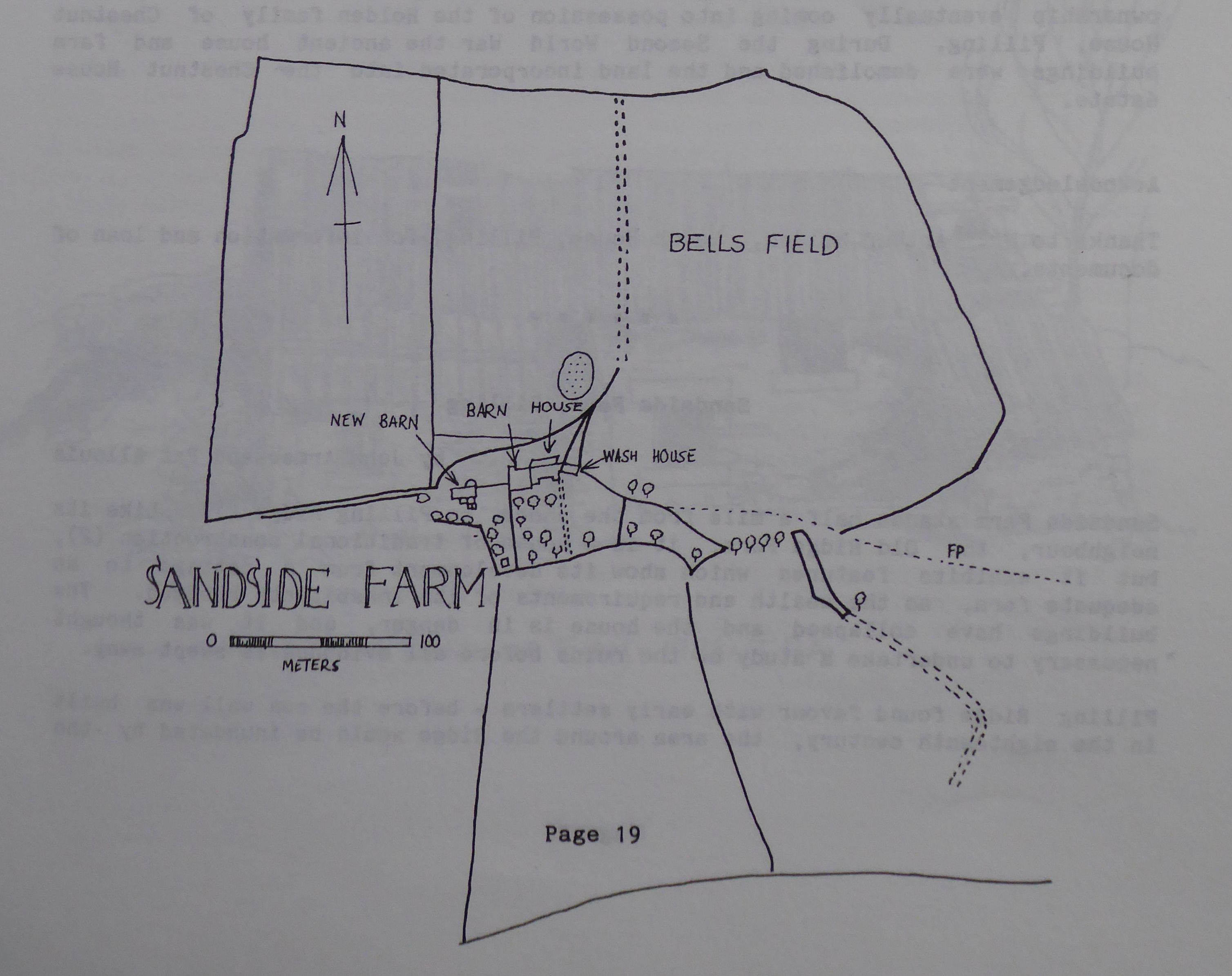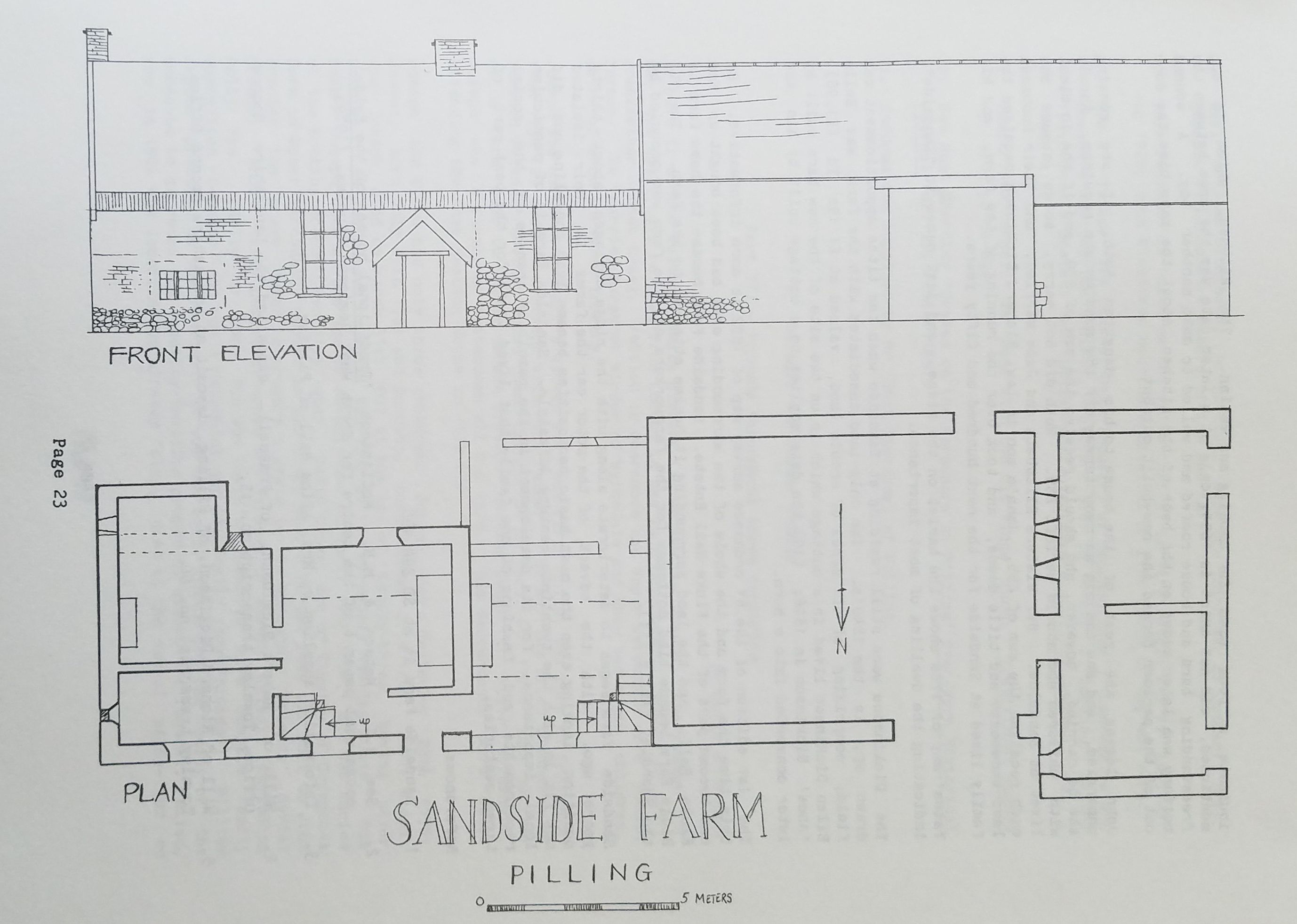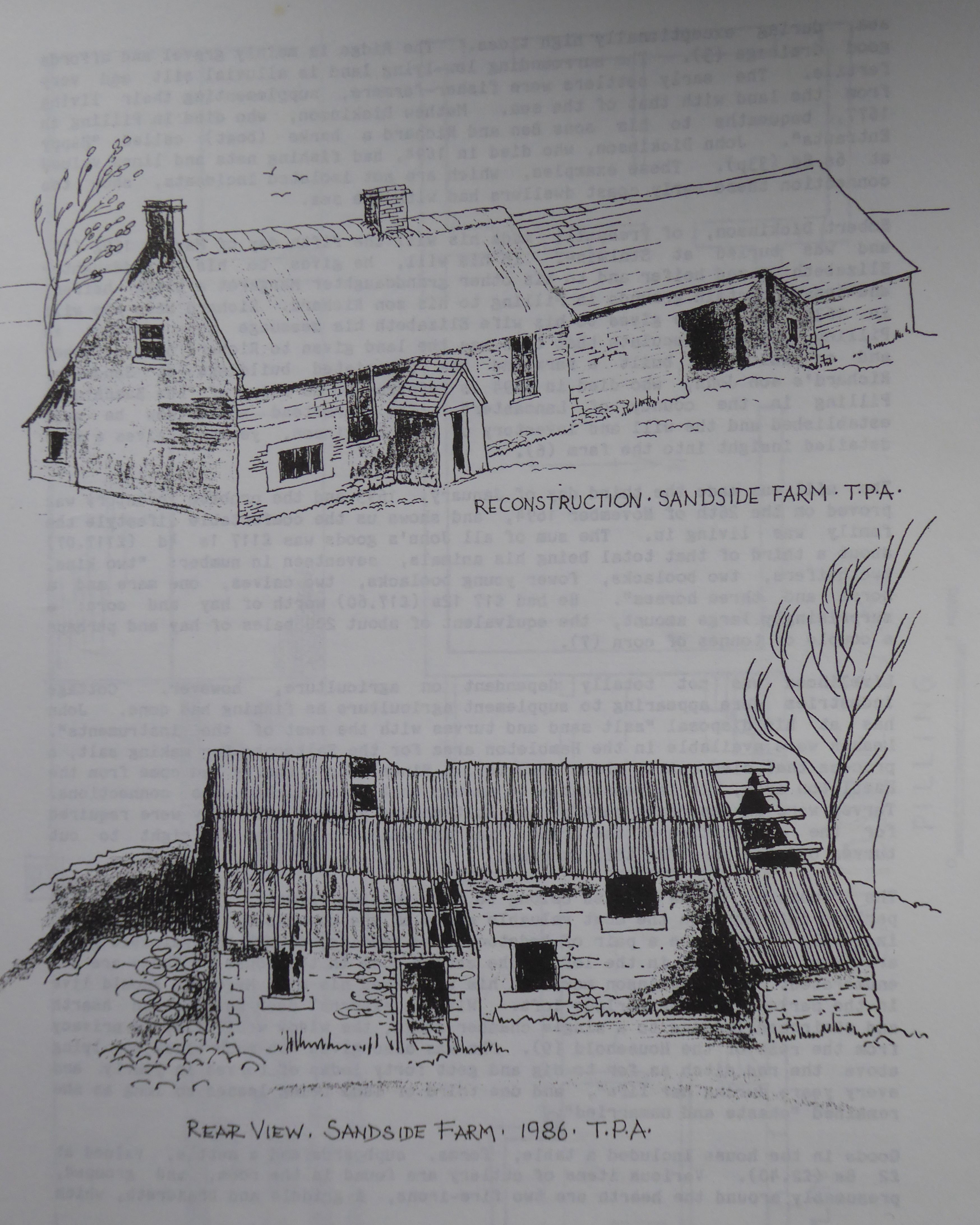Sandside Farm, Pilling by John Armer and Pat Allouis
Sandside Farm stands half a mile from the shore, on Pilling Ridge (1). Like its neighbour, the Old Ridge Farm, it is a house of traditional construction (2), but it exhibits features which show its development from a cottage to an adequate farm, as the wealth and requirements of its inhabitants changed. The buildings have collapsed and the house is in danger, and it was thought necessary to undertake a study of the ruins before all evidence is swept away.

Pilling Ridge found favour with early settlers - before the sea wall was built in the eighteenth century, the area around the Ridge would be inundated by the sea, during exceptionally high tides. The Ridge is mainly gravel and affords good drainage (3). The surrounding low-lying land is alluvial silt and very fertile. The early settlers were fisher-farmers, supplementing their living from the land with that of the sea. Mathew Dickinson, who died in Pilling in 1677, bequeaths to his sons Ben and Richard a barke (boat) called "Happy Entrants". John Dickinson, who died in 1694, had fishing nets and lines valued at 6s 8d (33p). These examples, which are not isolated incidents, show the connection these early coast dwellers had with the sea.
Robert Dickinson, of Preesall, made his will the fifth day of May in 1592 (4), and was buried at Stalmine. In his will, he gives to his granddaughter Elizabeth a red heifer and to his other granddaughter Margaret a black heifer, and leases certain grounds in Pilling to his son Richard. Richard made his will in 1630 (5) and he gives to his wife Elizabeth his messuage and tenement in Pilling. We may speculate that this was the land given to Richard by his father and on which he built a farm and its associated buildings at Sandside. Richard's son John, who died in 1694 is referred to as being of "the Sandsid in Pilling in the county of Lancaster". The farmstead would now be well established and the will and inventory of John Dickinson, yeoman, gives a more detailed insight into the farm (6).
The will was made the third day of January, 1693 and the probate inventory was proved on the 26th of November 1694, and shows us the comfortable lifestyle the family was living in. The sum of all John's goods was £117 1s 4d (£117.07) about a third of that total being his animals, seventeen in number: "two kine, two heifers, two boolacks, fower young boolacks, two calves, one mare and a horse and three horses". He had £17 12s (£17.60) worth of hay and corn: surprisingly large amount, the equivalent of about 200 bales of hay and perhaps a couple of tonnes of corn (7).
Livelihood was not totally dependent on agriculture, however. Cottage industries were appearing to supplement agriculture as fishing had done. John has at his disposal "salt sand and turves with the rest of the instruments". Leases were available in the Hambleton area for the Saltcoats for making salt, a process that died out in about 1720 (8). Since John's family had come from the Hambleton area, it is reasonable to assume that he still had some connections. Turves were an important part of the salt-making process, for they were required for the evaporation of the brine, and as tenant, John had the right to cut turves off the moss for this purpose.
The remaining goods listed belong to the dwelling house. The parlour and parlour loft contain the most valuable goods of the household, £10 6s (£10.30) in total. In each are a pair of bedstocks and bedding, though the valuable goods are kept in a chest in the loft, the safest room in the house. These are not enumerated. John Dickinson makes it his will that his wife Magdalen should live in the parlour and the parlour loft. With an external door and its own hearth and staircase leading to a single chamber above, the widow would live in privacy from the rest of the Household (9). She was also given "so much black mos lying above the red ditch as for to dig and gett forty lodes of torves in yearly and every yeare during her life", and one third of land being leased so long as she remained "chaste and unmarried".
Goods in the house included a table, forms, cupboards and a settle, valued at £2 8s (£2.40). Various items of cutlery are found in the room, and grouped, presumably around the hearth are two fire-irons, a griddle and brandreth, which indicate a room used for cooking and eating. The kitchen, which is not mentioned, did not exist in 1694; only at a later date was the area between the freestanding barn and house roofed and walled to make another bay. A second buttery was later added at the back of the kitchen, about the same time the door out of the parlour formed the new-built outshut.
John leaves the rest of the house to his daughter Ruth, if she remains unmarried, and she can dig as many turves off the moss as she requires. Should she be married, however, she should receive the sum of £30, and if she is blest with children she should be left £35. Ruth did not marry, so we assume she lived at Sandside. Her sisters Elizabeth and Jane married, and their husbands each received the sum of £55. John's son in law, Richard Dickinson received the land tenements and title deeds, and took over the running of the farm, and his family lived at Sandside for the next hundred and fifty years.
Yates' map of 1786 shows the hamlet on the ridge, and just names it "Sandside", indicating the dwelling of most importance.
The Dickinsons were still residing at Sandside when the tithe apportionment was drawn up, in the 1840's. The only land associated with the farm was Bells field, comprising of six acres of arable land, valued at £1 19s 7d (£1.98). Ellen Dickinson lived in a cottage which is on the site of the new barn built by 'shee' Dickinson in 1816; (10) the date applies to a cottage built by him and later converted into a barn.
The 1st edition of the 6" ordnance survey map of 1892 is more informative. By this time the farm and the whole of the surrounding area had been bought up and had become part of the Fluke Hall Estate. Sandside Farm became the home farm to Fluke Hall, and the land surrounding it became attached to the farm. The old Ridge Farm became tied cottages for the farmworkers and the farm was occupied by the Sherdley family (11).
Sandside Farm began to deteriorate along with the ridge cottages about thirty years ago. With the advent of the motor car the farms in their isolated position lacking even the most basic necessities became less appealing and did not fit in with the twentieth century lifestyle. Sandside Farm is of particular local importance, for its development is the result of changes in the social requirements and fashions of one family that lived there for the best part of
three centuries.

References
1. Sandside Farm is at SD 394 495
2. See R.C. Watson & M. E. McClintock 'Traditional houses of the Fylde' occasional paper 6 of the centre for North West Regional Studies. (1979)
3. Information supplied by Mrs. Alice Hall of Pilling.
4. Will of Robert Dickinson, of Preesall, deposited at Lancashire Record
office, Townley transcript no. 15.
5. Will of Richard Dickinson, of Pilling, deposit at Lancashire Record Office, Townley transcript no. 60.
6. Will of John Dickinson, of Pilling, made the third day of January 1693, deposit at Lancashire Record Office WRW 'A'.
7. This estimate is based on the value that £1 in 1690 equals £45 9s (£45.45) in 1985; John Dickinson had the equivalent of £780 worth of hay and corn.
8. See R. Taylor 'The Coastal Salt Industry of Amounderness', Lancashire and Cheshire Antiquarian Society, vol.78 (1974) pp 14-21; J. Daresbury Hatton 'Hambleton's ancient salt industry', Over-Wyre Historical Journal, vol. I (1980-81).
9. Comparison should be made with the Old Ridge Farm: Traditional Houses op. cit. pp 60-63.
10. See Hugh Sherdley 'Graves on the Foreshore at Pilling' Over-Wyre Historical Journal vol. III (1984-1985).
11. Information supplied by Mr. Hugh Sherdley, of Pilling.

